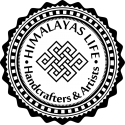Origin of Thangka Paintings
The actual origin of the Thangka paintings has been a subject of confusion. Some stories claim that Thangka originated from Tibet, some claim that they have been originated from Nepal, while some claim from India.
Table of Contents
Is it Nepal?
Though Thangka painting is believed to be painted in Tibet at first the real origin is from Nepal. It is because during the reign of King Songtsen Gampo in 6th century he invited artists from Nepal to paint the murals of the Tsuglagkhang temple. The temple is situated in the Tibetian city of Lhasa. After the daughter of Ansuvarama was married to Songtsen Gampo, the princess Bhrikuti started exporting the Thangka to Tibet. This is believed to have happened during the 7th century.
Not to get confused with the fact that Lord Buddha was born in Southern Nepal and Thangka and mandala paintings are painted on the ground of Buddhism and Hinduism so Thangka paintings might have been started from Nepal. There are numerous art schools and monasteries in Nepal where monks live and make Thangka paintings.
Many people get confused that all Buddhist stupas are Tibetan made and monks are Tibetan. This is very wrong. Yes, Of course! there are some group of monks migrated from Tibet to Nepal but not all monks and Thangka painters are Tibetian. Thangka is also called Pauda in the Nepali language. Thangka in Nepal are also made on the teaching of Hindu epics and the Puranas, living Newari goddesses Kumari and many more. Thus, these three pieces of evidence support Thangka paintings to be originated from Nepal.
Is it Tibet?
The word “Thangka” is a Tibetan word meaning “thing that one unrolls.” Thangka is also called “thang yig”, Tibetan word meaning a written record. The derivation of the word itself proves that Thangka might have been started from Tibet.
There was a tradition in Tibet: A travelling monks and lamas following Tibetan Buddhism would teach stories about Buddha and Buddhism through the Thangka paintings. So in early years, they used Thangka for teaching as it could be easily rolled and unrolled that was flexible and easy while travelling to different parts of Tibet. The next reason is that Tibetan monasteries have all different types of Thangka paintings and unique and old kind of Thangka paintings are seen well-preserved in Tibet in temple-like Potala Palace, Jokhang temple, Samye monasteries and so on.
On top of that majority of Buddhist masters in the world are from Tibet. This is the strong ground for starting of Thangka painting in Tibet.
After China occupied Tibet, thousands of monasteries and temples were destroyed and communist propaganda was forced upon the Tibetan people. After this incident, thousands of monks moved to Himalayas, India, Burma and other parts of Asia.
Is it India?
India has been a land of peace and Spirituality from the beginning of civilization. Hindu stories and myths are believed to be originated from India. Thus there was tradition to build mandala paintings in India from the very early period. Shri Yantra and other paintings portraying Hindu deities, sequences of Ramayana and Mahabharata were made. As Tibetan started painting Thangka after moving to India, there is no such strong evidence that Buddhist Thangka artists and paintings started from India. It is believed that in India Thangka paintings were influenced by Bhutan. The actual growth and expansion of the art of Thangka painting in Bhutan took place during the time of the unifier, Shabdrung when he invited scholarly artists from Tibet to spread knowledge of Buddhism and art of their simple living. Another popularly practised style of Thangka painting in Bhutan is the Mendre style. It was brought to Bhutan by a Tibetan artist Menlha Dondup, according to Dasho Karma Galey, a Bhutanese Buddhist scholar.
There is really big confusion about the exact origin of the thangka. What might be the possible reasons for tracing the origin of Thangka paintings?
Here are some specificities: – They don’t carry name of the Artists – They don’t contain date when painting was made – As all of the Thangka paintings are based on the knowledge and teachings of Buddhism it is also difficult to predict looking at the paintings as they carry same message and meanings.









